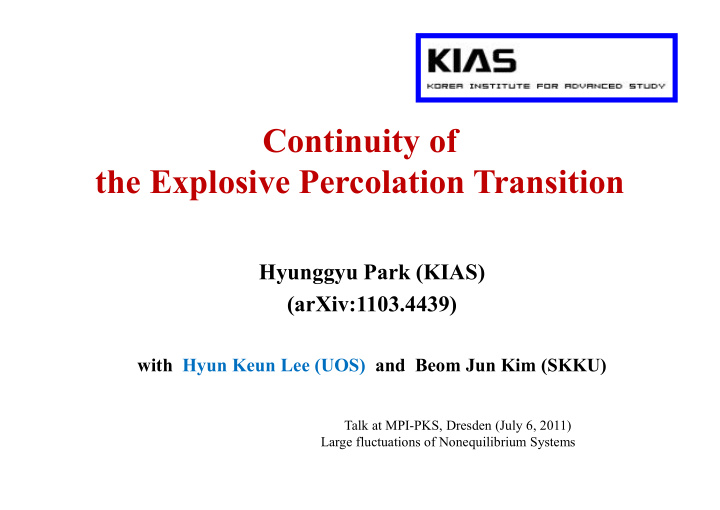



Continuity of the Explosive Percolation Transition Hyunggyu Park (KIAS) (arXiv:1103.4439) with Hyun Keun Lee (UOS) and Beom Jun Kim (SKKU) Talk at MPI-PKS, Dresden (July 6, 2011) Large fluctuations of Nonequilibrium Systems
Outline • Introduction – Ordinary Percolation – Achlioptas Process (AP) and Explosive Percolation (Science’09) • Controversial issue: Discontinuous or continuous transition on CG ? Scaling compatible with discontinuity? – Powder keg argument (Friedman & Lansberg, PRL’09) – Finite size scaling and infinite slope (Cho et al (SNU), PRE’10) – many others …. supporting discontinuity. – da Costa et al (Aveiro) claim continuity (PRL’10 Dec.) through accurate numerics and “approximate” analytic confirmation (indirect way). – a few supporters … (?) • Results based on extensive numerical simulations (N~10 11 ) – Novel approach to explore (dis)continuity at the transition. – Conclusive & decisive evidence for continuity !! – Explicitly shown that Scaling rules out the possibility of discontinuity. • Some Remarks.
Ordinary Percolation on complete graph [random graph model by Erdos & Renyi] • Start with isolated nodes & add a link one by one. - A pair of nodes are chosen randomly at each step. - If not linked already, add a new link between them. - Repeat this procedure. (Cluster merging process) • cluster: a set of connected nodes [size : number of nodes in cluster] • : number of nodes in system • : number of clusters in system • : number of time steps (link) • : time (link density)
• : the largest cluster size at • : percolation order parameter • : cluster size distribution at
Achlioptas process on complete graph [ADS, Science’09] • Start with isolated nodes & add a link one by one. - Two pair of nodes are chosen randomly at each step. - Select a pair minimizing the product of two merging cluster sizes - Add a link and repeat this procedure. PR (Product Rule) (Suppress the emergence of a big cluster)
Powder keg argument [FL, PRL’09] • Imagine a cluster set composed of - mean cluster size - no. of clusters - no. of total nodes • Adding links may merge all clusters in this set, and result in a macro cluster of size • Merging time • Just circumstantial description or Discontinuity at the transition Explanation of the apparent discontinuity NOT provide an evidence.
FSS & infinite slope [CKNKK, PRE’10] • All finite-size curves intersect at “one” point. • The slope of the curve at the crossing point diverges as . • Slope divergence at finite height of Very slow downward floating of the intersection points . In fact, they found • Discontinuity at the that it moves like , which transition is neglected. Actually we expect exactly the same behavior to support a continuous transition.
Continuity supported by a scaling relation [dCDGM, PRL’10] • A little modified version of the AP for analytical treatment. • High-precision Master equation approach , but only up to • Analytic relation derived as • Numerical values satisfy this scaling relation well. Really ? • Continuity at the transition Are this fitting and approximate accordance with the scaling relation good enough to make sure there is no jump at the transition? We think this is NOT “decisive” evidence for the continuity. Better way??
Our strategy • Set up a lower and upper bound (pseudo-transition point) for finite size below and above the true asymptotic percolation transition point . • We expect that both points, and converge to . • Find the upper bound for • We will show that this upper bound vanish as • This will complete the proof of continuity.
Symptoms of Percolation • Point of the maximum of cluster size heterogeneity (no. of distinct cluster sizes). • System is “ready” to explode at this point. • Conjecture this point serves as lower bound • Point right after the maximum growth rate of the largest cluster • Equivalent to right after the maximum size of the second largest cluster • Conjecture this point serves as upper bound • Both points are microscopically defined (sample-to-sample variation)!
Upper pseudo-transition point: t 2 • Second-largest cluster never recovers its size after merging into the largest cluster. • Indeed above t c . • Sample-to-sample fluctuations decrease fast with N (~N -1/2 ).
Upper pseudo-transition point: t 2 • Discontinuity can be examined by the information at only. Discontinuity believer Continuity believer
Lower pseudo-transition point: t 1 • Much shorter upper cutoff with a hump near the end. • Indeed, below t c . • Sample-to-sample fluctuations also decrease fast with N (~N -1/2 ).
Lower pseudo-transition point: t 1
Lower pseudo-transition point: t 1 • PERFECT single-parameter scaling collapse !!
t 2 (N) and t 1 (N)
Upper bound for ∆g • Discontinuity is examined by the accurate cluster distribution information at . • Consider the imaginary process to maximize the largest cluster growth, starting from a cluster distribution at and adding links by the amount of . • This imaginary process can be achieved by merging the largest and 2 nd largest cluster at each step and just iterating. • The resulting largest cluster size must be the maximally possible size at by the growth starting from .
Upper bound for ∆g
Some Remarks • Explosiveness in the AP on the complete graph is not enough to invoke the discontinuity. The explosive percolation transition is continuous. • However, it is different from the ordinary continuous transition, because the order parameter in the finite-size system does not change smoothly. Grassberger et al (arXiv:1103.3728) Riordan & Warnke (arXiv:1102.5306) • Even at , • Weird FSS ? • Applicable to many other models. Universality? “Long-range” models • SF networks ? Low dimensions? Nontrivial discontinuous transition?
Recommend
More recommend